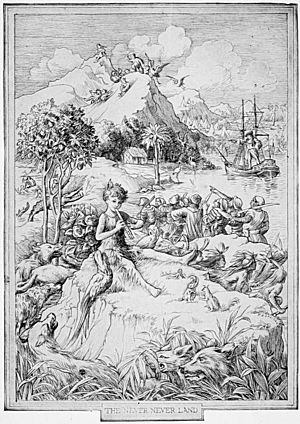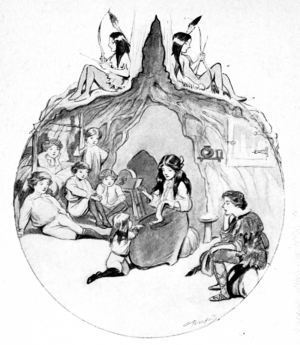Peter and Wendy facts for kids
Quick facts for kids Peter Pan; or, the Boy Who Wouldn't Grow Up |
|
|---|---|
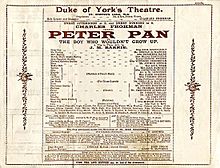
1904 programme for original play at the Duke of York's Theatre, London
|
|
| Written by | J. M. Barrie |
| Date of premiere | 27 December 1904 |
| Original language | English |
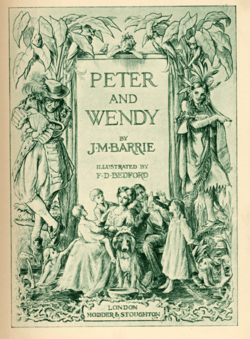
Title page, 1911 UK edition
|
|
| Author | J. M. Barrie |
|---|---|
| Illustrator | F. D. Bedford |
| Country | United Kingdom |
| Language | English |
| Genre | Fantasy |
| Publisher |
|
| Media type | |
| Pages | 267 pp.; Frontispiece and 11 half-tone plates |
| Preceded by | |
Peter Pan; or, the Boy Who Wouldn't Grow Up or Peter and Wendy, often just called Peter Pan, is a famous story by J. M. Barrie. It started as a play in 1904 and later became a novel in 1911. Both versions tell the exciting tale of Peter Pan. He is a playful and innocent boy who can fly!
Peter has many adventures on a magical island called Neverland. This island is full of amazing creatures like mermaids, fairies, Native Americans, and pirates. The Peter Pan stories also feature other well-known characters. These include Wendy Darling and her two brothers, Peter's tiny fairy friend Tinker Bell, the Lost Boys, and the scary pirate Captain Hook.
The play first opened in London on December 27, 1904. It was performed at the Duke of York's Theatre. An actress named Nina Boucicault played Peter Pan. The play became very popular and has been adapted many times. It has been made into stage musicals, TV shows, and several films. These include the famous 1953 Disney animated movie and a 2003 live-action film.
The novel was first published in 1911. It came out in the UK and the US. In 1929, J. M. Barrie gave the rights to his Peter Pan works to Great Ormond Street Hospital. This is a children's hospital in London. This gift helps the hospital take care of sick children.
Contents
How the Story Began
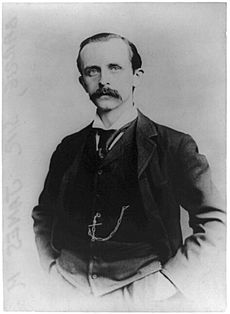
J. M. Barrie created Peter Pan from stories he told to his friends' sons. These were the boys of the Llewelyn Davies family. Barrie became very close to them. After their parents passed away, Barrie became a guardian for the boys. He unofficially adopted them.
The name "Peter Pan" comes from two places. "Peter" came from Peter Llewelyn Davies, one of the boys. "Pan" came from Pan, the playful Greek god of the forests. Some people think Peter's character was also inspired by Barrie's older brother, David. David died in a skating accident when he was 14. This deeply affected their mother. Barrie might have found comfort in the idea that David, by dying young, would stay a boy forever.
Peter Pan first appeared in a book in 1902. It was a novel for adults called The Little White Bird. The character then appeared in the stage play Peter Pan, or The Boy Who Wouldn't Grow Up. This play was a huge success when it opened in 1904. In 1906, the parts of The Little White Bird that featured Peter Pan were published as a separate book. It was called Peter Pan in Kensington Gardens.
Barrie then turned his play into the 1911 novel Peter and Wendy. This book is often just called Peter Pan today.
What Happens in the Story
The play and novel tell the most famous version of the Peter Pan story. While they have small differences, the main plot is the same.
Peter Pan often visits the Darling family's house at night. He listens to Mrs. Mary Darling's bedtime stories. One night, Peter is seen and loses his shadow while trying to escape. When he comes back for it, he wakes Wendy Darling. Wendy helps him re-attach his shadow. Peter learns that Wendy knows many stories. He invites her to Neverland to be a mother to his group, the Lost Boys. These are children who got lost in Kensington Gardens. Wendy agrees, and her brothers John and Michael join them.
Their magical flight to Neverland leads to many adventures. The children are almost hit by a cannonball. Wendy is nearly hurt by a Lost Boy named Tootles. Peter and the Lost Boys build a small house for Wendy. This is where she can recover. Soon, John and Michael start acting like Lost Boys too.
Peter welcomes Wendy to his home under the ground. She quickly becomes like a mother to everyone. Peter takes the Darlings on several adventures. One dangerous adventure happens at Mermaids' Lagoon. Here, Peter and the Lost Boys save Princess Tiger Lily. They also fight the pirates, including the evil Captain Hook. Hook is Peter's enemy. He is called Hook because Peter cut off his hand in a fight. A crocodile then ate Hook's hand. This crocodile now chases Hook, wanting to eat the rest of him. The crocodile also swallowed a ticking clock. So, Hook is scared of ticking sounds. Peter gets hurt when Hook scratches him. He thinks he will die, stuck on a rock as the tide rises. But he sees death as "an awfully big adventure." Luckily, the Neverbird lets him use her nest as a boat. Peter sails home safely.
Because Peter saved Tiger Lily, her tribe protects his home from pirates. Meanwhile, Wendy starts to like Peter. She asks him how he feels about her. Peter says he sees her like a faithful son. One day, Wendy tells stories to the Lost Boys and her brothers. She remembers her parents and decides to go back to England. Sadly, Captain Hook captures Wendy and the boys. Hook also tries to poison Peter's medicine while he sleeps. When Peter wakes up, Tinker Bell tells him Wendy is kidnapped. To make Wendy happy, Peter goes to drink his medicine. Tink doesn't have time to warn him about the poison. So, she drinks it herself, almost dying. Tink tells Peter she can be saved if children believe in fairies. In a famous part of the play, Peter asks the audience to clap their hands if they believe in fairies.
Peter goes to Hook's ship. On the way, he hears the ticking crocodile. Peter copies the ticking sound. He hopes animals will hear it and leave him alone. He doesn't realize he is still ticking when he gets on the ship. Hook gets scared, thinking it's the crocodile. While the pirates look for the croc, Peter sneaks in. He steals the keys and frees the Lost Boys. When the pirates check the cabin, Peter defeats them. He finally shows himself, and he and Hook have their big fight. Peter easily wins. He kicks Hook into the crocodile's mouth. Hook dies, happy that Peter kicked him off the ship, which Hook thought was "bad form." Then Peter takes control of the ship. He sails it back to London.
In the end, Wendy decides her place is at home. Her mother is very happy. Wendy brings all the boys except Peter back to London. Before they arrive, Peter flies ahead. He tries to close the window so Wendy will think her mother forgot her. But when he sees Mrs. Darling's sadness, he leaves the window open and flies away. Peter comes back briefly. He meets Mrs. Darling, who agrees to adopt the Lost Boys. She offers to adopt Peter too. But Peter refuses. He is afraid they will "catch him and make him a man." It is hinted that Mary Darling knew Peter when she was a girl. She seems changed a little after Peter leaves.
Peter promises to return for Wendy every spring. The play's last scene is a year later. Wendy is getting ready to go home after spring cleaning. It is said that Tinker Bell has died. Fairies don't live very long. But Peter has already forgotten about Tinker Bell, the Lost Boys, and even Hook. He doesn't understand Wendy's wish that she could take him back. The play's narrator says, "If he could get the hang of the thing his cry might become 'To live would be an awfully big adventure!'"
What Happens Later
Four years after the play first opened, Barrie wrote an extra scene. It was called When Wendy Grew Up. An Afterthought. This scene was later added to the end of the Peter and Wendy novel.
In this scene, Peter returns for Wendy many years later. But Wendy is now grown up. She has a daughter named Jane. It is also revealed that Wendy married one of the Lost Boys. However, the story never says which one. When Peter learns Wendy has "betrayed" him by growing up, he is sad. But then Jane agrees to come to Neverland as Peter's new mother. In the novel's last sentences, Barrie says Jane also grew up. Peter now takes Jane's daughter, Margaret, to Neverland. Barrie says this will go on forever. It will happen as long as children are "gay and innocent and heartless."
This extra scene is sometimes used in plays. It was also in the musical production with Mary Martin. It also inspired Disney's movie sequel, Return to Never Land.
Main Characters
Peter Pan
Peter Pan is the main hero of the play and novel. The book describes him as a young boy with all his baby teeth. He wears clothes made of leaves. He plays the pipes. He is the only boy who can fly without Tinker Bell's fairy dust. He doesn't want to grow up. He doesn't trust mothers because he felt his own mother betrayed him. He cares about Wendy. But he only sees her as a mother figure, not a girlfriend. Barrie says this is part of "the riddle of his very being."
The Darling Family
The Darling family lives in Bloomsbury, London.
- Wendy Darling – Wendy is the oldest child and the only daughter. She loves making a home and telling stories. She wants to be a mother. Her dreams are about adventures in a small woodland house. She doesn't like Tiger Lily much because they both like Peter. Tinker Bell is always saying bad things about Wendy. She even tries to get her killed. At the end of the novel, Wendy is grown up. She is married and has a daughter (Jane) and a granddaughter (Margaret). Wendy is often called the "mother" of the Lost Boys. Peter also sees her as his "mother." He acts like the "father," as if they are a married couple in their games.
- Some writers say Barrie was the first to use the name Wendy in a book. The name might have come from Barrie's young friend, Margaret Henley. She was the daughter of a poet. She said "friend" as "Fwiendy." Barrie changed this to "Wendy."
- John Darling – John is the middle child. He gets along well with Wendy. But he often argues with Michael. He loves pirates. He once thought about becoming "Redhanded Jack." He looks up to Peter Pan. But sometimes they argue because Peter likes to show off. He also looks up to his father. He dreams of running his father's business when he grows up.
- Michael Darling – Michael is the youngest child. He is about five years old. He wears the pinafores that young boys wore back then. He looks up to John and Wendy. He dreams of living in a wigwam. He was named after Michael Llewelyn Davies.
- Mr. and Mrs. Darling – George and Mary Darling are the children's loving parents. Mr. Darling is a bit proud and loud. He works in the City. But he is kind at heart. Mary Darling is smart and romantic. It is hinted that she knew Peter Pan when she was a girl. In the play, the same actor usually plays both Mr. Darling and Captain Hook.
- Nana is a Newfoundland dog. She works as a nanny for the Darling family. Nana doesn't talk. She acts like a very smart dog. She seems to understand her duties. In plays, an actor in a dog costume plays her.
- Liza is the Darling family's maid. She appears mostly in the first part of the story.
The Lost Boys
- Tootles – Tootles is the most humble Lost Boy. He often misses out on adventures. He can be silly. But he is always the first to defend Wendy. He accidentally shoots her before they meet because Tinker Bell tricks him. He grows up to become a judge.
- Nibs – Nibs is described as "gay and debonair" (meaning cheerful and charming). He is probably the bravest Lost Boy. He says the only thing he remembers about his mother is that she wanted a cheque-book. He would love to give her one, but he doesn't know what it is. He is also the oldest and best-looking Lost Boy.
- Slightly – Slightly is the most self-important. He thinks he remembers life before he was "lost." He is the only Lost Boy who "knows" his last name. He says his pinafore had "Slightly Soiled" on the tag. He makes whistles from tree branches. He dances to his own tunes. Slightly is not very good at make-believe. He takes big breaths when he's in trouble. He almost causes Peter's downfall.
- Curly – Curly is the most troublesome Lost Boy.
- The Twins – The First and Second Twin know little about themselves. Peter Pan doesn't know what twins are. He thinks they are two parts of the same person. This is why the Twins often finish each other's sentences.
Neverland Inhabitants
- Tiger Lily is the proud princess of the Piccaninny tribe. She is old enough to be married. But she refuses all suitors because she likes Peter. She is jealous of Wendy and Tinker Bell. Captain Hook almost kills Tiger Lily. But Peter saves her.
- Tinker Bell is Peter Pan's fairy. She is a common fairy who mends pots. She can be naughty and mean sometimes. But other times, she is helpful and kind to Peter. She has strong feelings for him. Fairies can only feel one strong emotion at a time. This explains her changing moods. In Barrie's book, Peter forgets about Tinker Bell when he returns for Wendy the next year. He says she "is no more" because fairies don't live long.
- Captain James Hook is the main bad guy. He is a pirate who wants to kill Peter Pan. Not just because Peter cut off his hand. But because Peter is "cocky" and makes Hook mad. He is the captain of the ship Jolly Roger. He cares a lot about "good form" (proper behavior). Hook dies when a crocodile eats him. In the play, the same actor who plays Mr. Darling also plays Captain Hook.
- Mr. Smee is an Irish pirate. He is the boatswain (a ship's officer) of the Jolly Roger. Smee is one of only two pirates who survive Peter Pan's attack. He later claims he was the only man Captain Hook ever feared.
- Gentleman Starkey was once a school usher. He is Captain Hook's first mate. Starkey is the other pirate who escapes Peter Pan's attack. He swims to shore and becomes a babysitter for the Piccaninny Tribe.
- Fairies – In the novel Peter and Wendy, there are other fairies in Neverland besides Tinker Bell.
- Mermaids live in the waters near Neverland. They are very beautiful and mysterious. But they are also vain and mean. Barrie says mermaids are only friendly to Peter. They will splash or try to drown anyone else who comes too close. It is dangerous to go to Mermaids' Lagoon at night. That's when mermaids sing hauntingly and make strange wailing cries to attract people.
- The Crocodile is Captain Hook's enemy. During a sword fight, Peter cut off Hook's right hand. He fed it to a crocodile. The crocodile has followed Hook ever since, wanting more. The crocodile also swallowed a clock. Its ticking sound warns Hook that it's near. At the end of the story, Captain Hook falls into the crocodile's mouth and is eaten.
Main Ideas in the Story
The play's subtitle, "The Boy Who Wouldn't Grow Up," shows the main idea. It's about the difference between being an innocent child and having the responsibilities of an adult. Peter chooses not to grow up. He encourages other children to do the same. But the novel starts with, "All children, except one, grow up." This shows that not growing up is not realistic. There's a sad side to it.
The story also has a small romantic part. Most children's versions, like the 1953 Disney film, don't show any romance between Wendy and Peter. But Barrie's original play and novel, and some later films, hint at romantic feelings.
Stage Shows
The first stage show was in London on December 27, 1904. Gerald du Maurier played Captain Hook and Mr. Darling. Nina Boucicault played Peter. Tinker Bell was shown on stage by a moving light. Her voice was made with bells.
It is a tradition in Peter Pan plays for the same actor to play Mr. Darling (the children's father) and Captain Hook. This was first done to use the actor fully. But some people think it shows a link between the two characters. They are both important figures in the children's lives. It also makes a strong contrast between Mr. Darling's harmless fussiness and Captain Hook's proud vanity.
Maude Adams played Peter in the 1905 Broadway show in New York City. She played the role for over ten years. In the U.S., she was the main image of Peter Pan for a long time. Later, Eva Le Gallienne directed and played Peter Pan in 1928. Her show was the first where Peter flew over the audience. The most famous musical version in the U.S. was the 1954 American musical. It starred Mary Martin. This version was shown on TV many times.
Other Versions of the Story
The story of Peter Pan has been made into many other things. It has been used for movies (live-action and animated), stage musicals, TV shows, and more. The most famous are the 1953 animated movie by Walt Disney. It featured the voice of 15-year-old Bobby Driscoll. He was one of the first male actors to play Peter. The role was usually played by women. Also famous are the musical shows starring Mary Martin, Sandy Duncan, and Cathy Rigby. The 2003 live-action movie directed by P. J. Hogan is also well-known. It starred Jeremy Sumpter and Jason Isaacs.
There have been new stories added to Peter Pan's world. These include the official sequel novel Peter Pan in Scarlet. There are also popular sequel films like Return to Never Land and Hook. Many characters from the story appear in other places. Tinker Bell, for example, is a famous character for Disney.
Who Owns the Story?
The rights to the Peter Pan story and its characters have been discussed a lot. This is especially true as the original story started to become public domain. In 1929, Barrie gave the rights to his Peter Pan works to Great Ormond Street Hospital (GOSH). This is a top children's hospital in Britain. He asked that the value of this gift never be told. This gift was confirmed in his will. GOSH uses these rights around the world to help support the hospital's work.
In the United Kingdom
The UK copyright for Peter Pan was supposed to end in 1987. This was 50 years after Barrie's death. But it was brought back in 1995. This happened when laws changed in the EU. The copyright term was extended to 70 years after the author's death. However, in 1988, a law was passed. It gave the hospital a right to get money forever from any performance, book, or TV show of the play or its adaptations. This law does not give the hospital full control over the story. It does not cover the Peter Pan part of The Little White Bird.
In the United States
Great Ormond Street Hospital (GOSH) says that U.S. laws give them copyright over "Peter Pan" until 2023. This is for the play script published in 1928. But GOSH agrees that the copyright for the novel version, published in 1911, has ended in the United States.
The original versions of the play and novel are now in the public domain in most parts of the world. This means anyone can use them without paying royalties.
See also
 In Spanish: Peter Pan y Wendy para niños
In Spanish: Peter Pan y Wendy para niños


